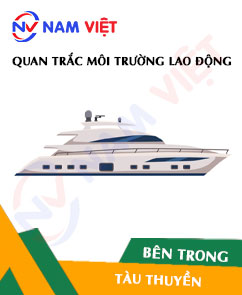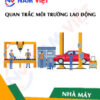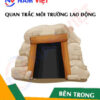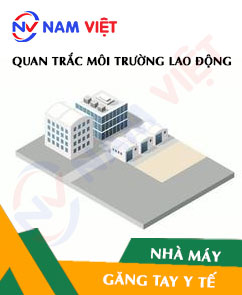Occupational environment monitoring spaces on ships
99,000 ₫
Note: The above price is calculated for one sample, and the price may fluctuate depending on the area of the environment to be monitored and market movements. For more accurate pricing support, please refer to the price list or contact our consulting staff directly.
Monitoring the environment of spaces on ships is a session of collecting, analyzing, and evaluating factors at the workplace that may harm workers health.
Table of Contents
Toggle1. Overview of the space on ships
a. What is the space on ships?
The space on ships refers to the interior areas of a ship where crew members and passengers live and work during sea voyages. The ship’s space may include multiple areas and rooms, depending on the type of ship and its purpose.
Main areas in the space on ships include:
- Cabin: This is the area containing beds and personal amenities for crew members or passengers on the ship. Cabins are usually equipped with beds, wardrobes, small desks, and private bathrooms.
- Restaurant and dining area: This is the space dedicated to serving food and beverages on the ship. Ship restaurants often have multiple seating areas and diverse menus to meet passengers’ dining needs.
- Conference rooms and meeting rooms: For commercial or naval ships, there may be meeting rooms or conference rooms for meetings, discussions, and work-related activities.
- Public areas: These are common spaces for everyone on the ship. This area may include waiting rooms, lobbies, reception desks, entertainment rooms, libraries, or relaxation zones.
- Control stations and technical facilities: On large ships, there are control stations and control rooms to manage and operate the ship. Technical facilities provide maintenance and repair services for equipment and systems on the ship.
The space on ships is designed to ensure comfort, safety, and convenience for crew members and passengers throughout the sea voyage.

b. Jobs inside the space on ships
There are various jobs that can be performed inside the space on ships, depending on the type of ship and its purpose. Some common jobs include:
- Ship operation and navigation: Crew members are assigned to operate and navigate the ship, including captains, sailors, and navigation staff.
- Management and operation of technology and systems: Engineers and technicians on the ship are responsible for managing, maintaining, and repairing electrical systems, air conditioning, automation, information and telecommunications systems, and other shipboard systems.
- Operation and maintenance of equipment and machinery: Workers and technicians perform repair, maintenance, and operation of equipment and machinery on the ship, including engines, electrical systems, refrigeration systems, fuel supply systems, and other systems.
- Passenger management and service: Passenger service staff, such as attendants or tour staff on cruise ships, are responsible for assisting and managing passengers, including providing information, safety guidance, and responding to passenger requests.
- Medical services: Doctors, nurses, and medical personnel on ships provide healthcare for crew members and passengers, including health check-ups, emergency care, and responses in emergencies.
- Management and operation of dining areas: Restaurant staff, chefs, and food service personnel manage and operate dining areas on the ship.

c. Types of machinery used in the space on ships
On ships, various types of machinery are used to support different activities and functions. Common machinery includes:
- Ship engines: These are the most important machinery on a ship. Ship engines provide energy for moving the vessel through water. Common engines include diesel engines, gasoline engines, marine engines, and steam engines.
- Electrical systems: These supply electricity to the entire ship, including generators, optical electrical systems, controllers, and other devices for powering onboard systems and equipment.
- Refrigeration and air conditioning systems: On large ships or cruise ships, these systems maintain temperature and humidity in living and working spaces.
- Air compressors: Used to provide compressed air for various devices and systems on the ship, including brakes, cleaning systems, and control systems.
- Pumps: Used to supply water or liquids in systems such as water supply, wastewater treatment, and fire-fighting systems.
- Generators: Used to provide backup electricity when needed or in case of power failure. Generators are usually powered by diesel or gasoline engines.
- Vacuum cleaners and floor scrubbers: Used to clean floors and other areas of the ship.

d. Occupational diseases for workers in ship spaces
Workers in ship spaces may suffer from some occupational diseases due to environmental and job-specific factors. Common occupational diseases include:
- Diseases related to ship operation and navigation: Workers in positions such as captain, sailor, and navigation staff may suffer from conditions related to exposure to marine environmental factors such as waves, motion, pressure, and marine climate.
- Chemical-related diseases: Workers in production, maintenance, and repair areas may be exposed to chemicals such as solvents, paints, cleaning agents, and additives. Improper safety compliance and lack of personal protective equipment can cause skin, respiratory, and digestive issues.
- Noise-related diseases: Noise from machinery and ship operations can cause hearing loss and other health problems.
- Motion-related diseases: Workers exposed to continuous ship movements, such as vibration and shocks, may suffer from dizziness, back pain, muscle strain, and digestive issues.
- Physical work-related diseases: Workers in confined spaces, lifting or transporting heavy objects, or working in fixed positions may develop musculoskeletal disorders affecting bones, muscles, and the back.

2. Overview of occupational environment monitoring services
a. What is occupational environment monitoring in ship spaces?
Occupational environment monitoring (or workplace environment measurement) in ship spaces involves collecting, evaluating, and analyzing measurement indicators of environmental factors to implement timely measures, minimize environmental impacts on workers’ health, and prevent occupational diseases. Monitoring is mandatory for ships.
Occupational environment monitoring plays a crucial role in protecting, improving, and maintaining workers’ health because labor is the primary resource directly generating profit. Workers frequently exposed to hazardous factors above permissible limits are at risk of health issues and occupational diseases.
REGISTER OCCUPATIONAL ENVIRONMENT MONITORING SERVICE
b. An Toan Nam Viet’s occupational environment monitoring program
An Toan Nam Viet’s program is researched by monitoring engineers specializing in occupational safety and environmental protection. It uses modern measurement methods to monitor air quality, water, microclimate, physical factors, and dust in the workplace. This program ensures a safe working environment and protects workers’ health.
Additionally, the program plays a key role in researching and developing new solutions to improve workplace environmental quality. With a dedicated and professional team, An Toan Nam Viet’s exclusive program is a breakthrough in occupational safety and environmental management in Vietnam.

c. Standardization in occupational environment measurement procedures
Standardization in An Toan Nam Viet’s procedures is crucial for ensuring the accuracy and reliability of measurement results. The program follows recognized standards and procedures of the Ho Chi Minh City Department of Health, ensuring collected data is highly reliable for assessing the workplace environment and making decisions to improve safety and protect workers’ health.
These standardized procedures also ensure measurements are conducted by highly qualified monitoring specialists with years of experience, allowing managers and experts to trust the results and make accurate, valuable decisions.
By applying standardization, An Toan Nam Viet demonstrates its commitment to a safe working environment, protecting workers’ health, and contributing to improving occupational safety and environmental management in Vietnam.
d. Reporting occupational environment monitoring results on ships
Monitoring results are prepared according to Form 04, Appendix III issued with Decree 44/2016/ND-CP in two copies: one sent to the workplace that signed the monitoring contract, and one retained by the monitoring organization.
Records are stored indefinitely according to legal regulations.

e. Frequency of occupational environment monitoring as required by law
According to Clause 2 of Article 18, Law on Occupational Safety and Hygiene 84/2015/QH13, employers must conduct occupational environment monitoring at least once a year.
f. Deadline for submitting occupational environment monitoring reports as required by law
The deadline is before December 31 each year. Businesses in production facilities must submit monitoring reports to the local Department of Health at the location of the business headquarters and where workers are employed.
If there are changes in technology, manufacturing processes, or upgrades that may introduce new hazardous factors, businesses must update occupational hygiene records regarding the hazardous factors requiring monitoring.
g. Penalties for violations of occupational environment monitoring regulations for employers
According to Article 27 of Decree No. 12/2022/ND-CP dated January 17, 2022:
- Clause 2: Fines from 2,000,000 – 5,000,000 VND for failing to publicly disclose monitoring results to workers at the workplace and areas under inspection immediately after receiving the results.
- Clause 3: Fines from 20,000,000 – 40,000,000 VND for failing to conduct occupational environment monitoring to control impacts on workers’ health as required by law.
- Clause 4: Fines from 40,000,000 – 60,000,000 VND for colluding with monitoring organizations to commit fraud in monitoring activities but not at a criminal level.
3. Harmful Environmental Factors for Workers in Shipboard Spaces
Workers operating in shipboard spaces may encounter the following harmful environmental factors:
- Engines and emissions: Ship engines produce exhaust fumes that may contain harmful substances such as carbon monoxide (CO), nitrogen oxides (NOx), and particulate matter. Prolonged exposure to these substances can lead to respiratory problems and overall health issues.
- Noise: Machinery, engines, and ship operations generate high levels of noise. Prolonged exposure to loud noise can negatively affect hearing, cause insomnia, stress, and impact general health.
- Vibration: Vibrations from machinery and ship operations can create high levels of vibration. Continuous exposure may cause fatigue, back pain, muscle strain, and musculoskeletal problems.
- Restricted working conditions: Working spaces on ships are often limited and may encounter harsh environmental conditions such as high temperature, humidity, concentrated air, or restricted ventilation. These factors can cause physical stress, fatigue, and difficulty adapting to the environment.
- Safety risks: Shipboard work may involve various safety risks such as fire and explosion hazards, collision risks, falls from height, and risk of injury during operations.

REGISTER FOR WORKPLACE ENVIRONMENT MONITORING SERVICE
4. Measures to Improve Working Conditions in Shipboard Spaces
To improve working conditions in shipboard spaces, the following measures can be applied:
- Ensure ventilation and air conditioning: Ensure ventilation and air conditioning systems operate effectively to maintain proper humidity, temperature, and air quality in working spaces.
- Noise control: Apply measures to reduce noise such as sound isolation, soundproofing, and using ear protection to safeguard workers’ hearing.
- Vibration reduction: Implement vibration isolation using damping materials and technical solutions to reduce vibrations from machinery and ship operations.
- Hazardous substance management: Ensure proper handling of hazardous waste and substances according to regulations, including using personal protective equipment, following safe working procedures, and regularly checking air quality to ensure worker safety.
- Improve workspace: Enhance working space by optimizing equipment layout, increasing ventilation, and ensuring sufficient, safe, and convenient areas for workers.
- Training and education: Provide training on occupational safety, industrial hygiene, and health protection measures for workers, including awareness of harmful environmental factors and prevention methods.
- Monitoring and assessment: Conduct regular inspections and evaluations of the working environment to identify and address safety and health issues, ensuring compliance with relevant regulations.
- Periodically conduct workplace environment monitoring in factories, collect and analyze harmful factors affecting workers, and implement adjustments to reduce hazards and prevent occupational diseases.
5. Benefits of Periodic Monitoring in Shipboard Spaces
An Toan Nam Viet provides businesses with excellent benefits when using workplace environment monitoring services in accordance with Decree 44/2016/ND-CP on managing and controlling harmful factors in working environments affecting employees.
- Businesses can proactively control harmful factors in workshops or factories.
- Receive recommendations on measures to reduce harmful factors and improve the quality of the working environment.
- Indirectly protect human resources, the key factor in enterprise development.
- Reduce the impact of occupational diseases on health, thereby minimizing future treatment costs.
- Improved employee health leads to better product quality and consistent production output.
- Comply with labor safety regulations and avoid legal risks.
- Enhance credibility and professionalism, elevating the business’s brand.
Nam Viet’s environmental monitoring service is a solution to minimize occupational disease risks, contributing to a clean and high-quality working environment.

6. Nationwide Workplace Environment Monitoring Center
Nam Viet Workplace Environment Monitoring Center is a professional unit specializing in monitoring and measuring workplace environmental quality throughout all provinces of Vietnam. With an experienced team of monitoring specialists, the center uses modern measuring equipment to ensure accuracy and reliability.
In addition to monitoring services, the center assists clients in planning, handling, and tracking workplace environmental issues. Following the motto “customer-centric,” the center prioritizes client satisfaction, meets all client needs, and provides the best solutions for businesses.
REGISTER FOR WORKPLACE ENVIRONMENT MONITORING SERVICE
With investment in technology, equipment, and personnel, Nam Viet’s monitoring center has become a reputable unit in workplace environment monitoring in Ho Chi Minh City, with objectives including:
- We always prioritize brand reputation and service quality.
- We provide clients with the best and most suitable solutions.
- Alongside a team of experienced Masters and Engineers committed to environmental protection and business benefits.
- By working with Nam Viet Environmental Monitoring, companies receive professional service from experts and the best cost advantages.
The workplace environment monitoring process at Nam Viet includes:
- Before monitoring, all machinery and equipment are calibrated according to legal regulations.
- Implement the complete monitoring process as committed to the Department of Health.
- Report monitoring results honestly to employers.
- If results indicate unsafe conditions, Nam Viet will provide solutions, and the enterprise will implement:
- Measures to improve working conditions, minimize harmful factor impacts, and prevent occupational diseases.
- Health check-ups to detect occupational and work-related diseases early for employees in unsafe environments.
- Provide in-kind benefits to employees according to labor laws.

7. Workplace Environment Monitoring Service Price List
To help businesses perform workplace environment monitoring professionally and effectively, Nam Viet provides clients with a quality and reasonably priced service price list.
- Our price list provides detailed information on the costs of monitoring services we offer, including transportation, measurement, analysis, and reporting. Clients can trust the accuracy and reliability of our monitoring reports.
- We commit to offering the most competitive and reasonable prices in the market and are always ready to answer questions about monitoring services quickly and professionally.
- With Nam Viet’s price list, clients can easily choose service packages that meet their needs. We are committed to delivering the highest satisfaction with professional service quality.
No comments yet












Review Occupational environment monitoring spaces on ships
There are no reviews yet.